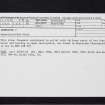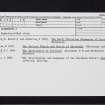Pricing Change
New pricing for orders of material from this site will come into place shortly. Charges for supply of digital images, digitisation on demand, prints and licensing will be altered.
Abernethy Churchyard, Ogam Stone
Ogham Inscribed Stone (Early Medieval)
Site Name Abernethy Churchyard, Ogam Stone
Classification Ogham Inscribed Stone (Early Medieval)
Alternative Name(s) Abernethy No. 2
Canmore ID 27926
Site Number NO11NE 2.01
NGR NO 1900 1641
NGR Description NO c. 1900 1641
Datum OSGB36 - NGR
Permalink http://canmore.org.uk/site/27926
- Council Perth And Kinross
- Parish Abernethy (Perth And Kinross)
- Former Region Tayside
- Former District Perth And Kinross
- Former County Perthshire
Abernethy 2 (?St Bridget), Perthshire, carved fragment
Measurements: H 0.36m, W 0.23m, D 0.07m
Stone type: sandstone
Place of discovery: NO 1900 1641
Present location: National Museums Scotland, Edinburgh (X.IB 98)
Evidence for discovery: found in the churchyard in 1890, it was presented to the museum in 1892 by Alexander Laing.
Present condition: damaged.
Description
This is part of a slab carved with figural ornament and an inscription in bind ogham. Three ogham letters appear within a band formed by two horizontal incised lines, above which are traces of two equine legs. The ogham reads QMI.
Date: ninth century.
References: Butler 1897, 230, pl 2; ECMS pt 3, 308-10; Forsyth 1996, 2-10.
Compiled by A Ritchie 2016
Abernethy
Abernethy lies to the south of the confluence of the rivers Earn and Tay and has produced a small but important collection of carved stones. They have all been trimmed for reuse as building stones, but they represent one Pictish symbol stone, at least four cross-slabs including one with part of an ogham inscription, and at least three free-standing crosses, one of which had a shaft carved with a fat plant scroll.
Primary reference: Proudfoot 1997
A Ritchie 2019
NO11NE 2.01 c. 1900 1641.
This stone fragment sculptured in relief with the lower parts of two legs of a horse and bearing an Ogam inscription, was found in Abernethy Churchyard. It is now in RMS (IB 98).
Proc Soc Antiq Scot 1892; J Rhys 1892; D Butler 1897; J R Allen and J Anderson 1903. F C Diack 1944.
There is no change to the existing record.
Information from RCAHMS (JRS), 27 November 1996.










